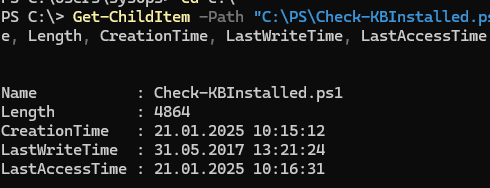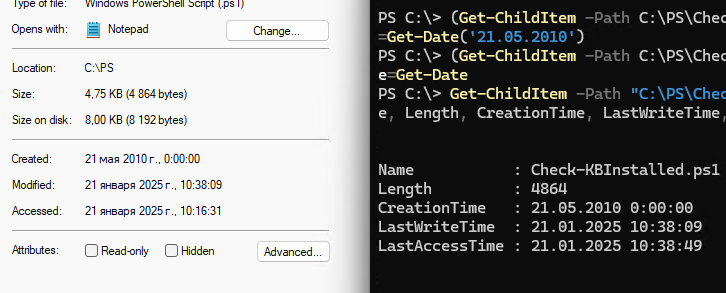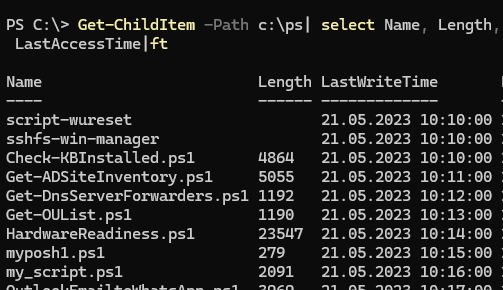С помощью PowerShell можно получить значения или изменить атрибуты файлов и папок на файловой системе. В этой статье мы рассмотрим, как работать с временными метками файлов с помощью PowerShell.
Вывести дату создания, изменения и последнего доступа (открытия) файла:
Get-ChildItem -Path C:\PS\Check-KBInstalled.ps1 | select Name, Length, CreationTime, LastWriteTime, LastAccessTime

С помощью меток времени можно быстро найти все файлы созданные/измененные за определенный промежуток времени. Например, вывести все файлы в папке, созданные за последние 30 дней:
Get-ChildItem -Path c:\ps -Recurse| where -Property CreationTime -gt (Get-Date).AddDays(-30)
Можно изменить значение любой из временных меток файла. Например, изменить дату создания файла:
(Get-ChildItem -Path C:\PS\Check-KBInstalled.ps1).CreationTime=Get-Date('21.05.2010')
Изменить время последнего изменения файла на текущую дату:
(Get-ChildItem -Path C:\PS\Check-KBInstalled.ps1).LastWriteTime=Get-Date
Проверим, что временные метки файла были изменены (с помощью PowerShell и в свойствах файла в проводнике Windows):

Эти же команды используются, чтобы изменить дату создания/модификации папки:
(Get-Item -Path C:\PS\).CreationTime=Get-Date('21.05.2010 10:10')
Если нужно изменить дату модификации у всех файлов и вложенных папок, можно использовать такой однострочник:
dir c:\PS -recurse | %{$_.LastWriteTime = Get-Date('21.05.2023 10:10')}
Если нужно сделать так, чтобы даты модификации файлов немного отличались (в этом примере на 1 минуту):
dir c:\ps -file -recurse|%{$i=0} {$_.LastWriteTime = (Get-Date('21.05.2023 10:10')).AddMinutes($i); $i++}

Обратите внимание, что формат даты будет отличаться в зависимости от локали компьютера. Например, на компьютере с русской локалью при попытке задать дату в американском формате (
MM/DD/YYYY
) будет ошибка:
Get-Date : Cannot bind parameter 'Date'. Cannot convert value "12/31/2024" to type "System.DateTime". Error: "String was not recognized as a valid DateTime."
Для универсальности скрипта можно предварительно конвертировать дату в нужный формат с помощью метода ParseExact:
(Get-Item -Path "C:\PS").CreationTime = [datetime]::ParseExact("12/31/2024", "MM/dd/yyyy", $null)
Если формат даты в выражении указан неверно, появится ошибка:
The DateTime represented by the string is not supported in calendar System.Globalization.GregorianCalendar.
on April 14, 2012
We can find creation date of a file from command line using dir command. The syntax for this is given below.
dir /T:C filename
If we need to get file creation date and time for all the files and subdirectories in the current directory, the command is:
dir /T:C
We can also restrict the output to specific file types using wildcards.
dir /T:C *.pdf
The above command would print file creation dates only for pdf files.
Command to print file creation date and time only for files(skip directories)
dir /A:-D /T:C
Find the latest created file in a directory:
The below command would print the files in the order of creation date & time. In this list the file that is created very recently would be displayed in the last position.
dir /A:-D /T:C /O:D
Example:
C:\>dir /A:-D /T:C /O:D 02/06/2012 07:38 PM 4 4.txt 02/06/2012 07:39 PM 0 5.txt 02/06/2012 10:45 PM 13 10.txt 02/06/2012 10:47 PM 13 newfile.t 02/11/2012 08:24 PM 83 2.bat 02/11/2012 08:26 PM 5,219 data.txt 02/11/2012 08:27 PM 5,219 data2.txt 02/12/2012 11:28 PM 98 3.bat 02/13/2012 10:47 AM 131 echo.bat
When managing files on a Windows system, you might often need to know when a file was created. In this PowerShell tutorial, we’ll explore various methods to get the file creation date using PowerShell with various examples.
To get the file creation date in PowerShell, you can use the Get-Item cmdlet followed by accessing the CreationTime property of the resulting object. For example:
$file = Get-Item "C:\MyFolder\MyFile.txt"
$creationDate = $file.CreationTime
Write-Output "The file was created on: $creationDate"This script will output the exact date and time when the file was created.
PowerShell provides various cmdlets to get the created date of a file. Let us explorer all these methods:
Method 1: Using Get-Item
The Get-Item cmdlet is the widely used PowerShell command for retrieving a file’s creation date. It retrieves the item at a specified location and returns an object that represents the item, including its properties.
Here’s a simple example:
$file = Get-Item "C:\MyFolder\Notes.docx"
$creationDate = $file.CreationTime
Write-Output "The file was created on: $creationDate"This script will output the creation date and time of the specified file. The CreationTime property of the file object contains the information we need.
I executed the PowerShell script, and you can see the output in the screenshot below:

Method 2: Using Get-ChildItem
If you are working with multiple files, then you can use the PowerShell Get-ChildItem cmdlet.
Here is an example to get the file creation date of all the files presented in a directory using PowerShell.
$files = Get-ChildItem "C:\MyFolder\*"
foreach ($file in $files) {
$creationDate = $file.CreationTime
Write-Output "The file $($file.Name) was created on: $creationDate"
}This script lists all the files in a directory and prints their creation dates. It’s particularly useful for inventorying multiple files.
You can see the output below, after I executed the above PowerShell script.

Method 3: Using the [System.IO.File] Class
If you want to use the .Net classes in PowerShell, then you can use the [System.IO.File] class to access the creation date of a file.
$filePath = "C:\MyFolder\Notes.docx"
$creationDate = [System.IO.File]::GetCreationTime($filePath)
Write-Output "The file was created on: $creationDate"This method directly taps into the .NET framework’s file handling capabilities, which can be more familiar to those with a background in .NET languages.
Method 4: Using WMI Objects
Windows Management Instrumentation (WMI) is another powerful feature that can be utilized with PowerShell to get file creation dates. Here’s how you can do it:
$filePath = "C:\MyFolder\file.txt"
$creationDate = Get-WmiObject -Query "SELECT CreationDate FROM CIM_DataFile WHERE Name = '$filePath'"
Write-Output "The file was created on: $($creationDate.ConvertToDateTime($creationDate.CreationDate))"This script uses WMI to query the CIM_DataFile class, which represents a data file on a computer system running Windows. Note that you need to replace the backslashes in the file path with double backslashes in the WMI query.
Method 5: Using PowerShell Custom Functions
You can also create a custom PowerShell function to encapsulate the logic for retrieving file creation dates and make it reusable.
function Get-FileCreationDate {
param (
[string]$filePath
)
$file = Get-Item $filePath
return $file.CreationTime
}
# Usage
$creationDate = Get-FileCreationDate -filePath "C:\MyFolder\file.txt"
Write-Output "The file was created on: $creationDate"With this function, you can easily call Get-FileCreationDate with different file paths to get their creation dates.
Conclusion
PowerShell offers multiple ways to retrieve the creation date of a file. In this PowerShell tutorial, I have explained how to get file creation date in PowerShell using various methods and I hope it will help you.
You may also like:
- How to Check if a File Contains a String in PowerShell?
- How to Get the Size of a File in PowerShell?
- How to Extract Directory from File Path in PowerShell?
- How to Get File Version in PowerShell?
- How to Check if a File is Empty with PowerShell?
Bijay Kumar is an esteemed author and the mind behind PowerShellFAQs.com, where he shares his extensive knowledge and expertise in PowerShell, with a particular focus on SharePoint projects. Recognized for his contributions to the tech community, Bijay has been honored with the prestigious Microsoft MVP award. With over 15 years of experience in the software industry, he has a rich professional background, having worked with industry giants such as HP and TCS. His insights and guidance have made him a respected figure in the world of software development and administration. Read more.
How to Get File Creation and Modification Date/Time on Linux and Windows 📂🕐
Have you ever wondered how to retrieve the creation and modification dates/times of a file on both Linux and Windows? It can be a bit tricky to find a cross-platform solution that works seamlessly on both operating systems. Today, we’ll explore some common issues faced by developers and provide easy solutions to help you get these important file details. Let’s dive in! 💻🔍
The Challenge 🔄📝
The challenge arises from the difference in how Linux and Windows store file metadata. Linux systems use the Unix timestamp, which represents the number of seconds since January 1, 1970. On the other hand, Windows systems utilize a different mechanism to store file dates and times. This discrepancy often leads to confusion when trying to create a solution that works universally.
Solution 1: Use Python’s os Module 🐍📅
Python provides a convenient and cross-platform way to retrieve file dates and times using the os module. By leveraging this powerful module, you can write code that works equally well on both Linux and Windows. Here’s an example to get you started:
import os
def get_file_dates(file_path):
creation_time = os.path.getctime(file_path)
modification_time = os.path.getmtime(file_path)
return creation_time, modification_timeIn the above code snippet, we use the os.path.getctime() function to get the file’s creation time and os.path.getmtime() to get its modification time. Both these functions return the Unix timestamp representing the respective dates.
Solution 2: Use the stat Command in the Terminal 💻⚙️
If you prefer working with the command line, Linux provides the stat command to fetch file metadata, including creation and modification dates/times. Unfortunately, this command is not available natively on Windows, so this solution is limited to Linux systems. Here’s how you can use it:
stat -c '%w %y' <file_path>The %w placeholder represents the file’s creation time, while %y represents the modification time. Simply replace <file_path> with the actual path of the file you’re interested in.
Solution 3: Utilize Third-party Libraries 📦🌐
If you’re working with multiple programming languages or want more advanced capabilities, using third-party libraries can be beneficial. For example, in Java, you can use the Apache Commons IO library’s FileUtils class to obtain file dates and times. Similar libraries exist for other languages as well, providing cross-platform solutions with additional features.
Conclusion and Call-to-Action 🎉💬
Retrieving file creation and modification dates/times may seem daunting, but with the right approach, it doesn’t have to be. In this blog post, we discussed three different solutions to tackle this challenge. Whether you prefer Python, the command line, or third-party libraries, you now have the tools to get the job done on both Linux and Windows.
Now, it’s time for you to try it out! Which solution are you most excited to implement? Let us know in the comments below and share your experiences with others. Remember, learning is all about sharing knowledge! 🌟🚀
Get File Creation Date in C
To get the file creation date in C, use system-specific functions; on Unix-like systems, you can use the stat function (which may return the file’s status change time instead of the true creation time), and on Windows, you can use the Windows API functions such as GetFileTime to obtain the creation date.
Example 1: Using stat Function (Unix-like Systems)
This example demonstrates how to retrieve the file creation date (or the status change time on systems where creation time is unavailable) using the stat function. We will access the attributes of a file named “example.txt” and print its time.
main.c
#include <stdio.h>
#include <sys/stat.h>
#include <time.h>
int main() {
struct stat attr;
// Retrieve file attributes of "example.txt"
if (stat("example.txt", &attr) == 0) {
// Print the file creation (or status change) time
printf("File creation (or status change) time: %s", ctime(&attr.st_ctime));
} else {
perror("stat");
}
return 0;
}Explanation:
struct stat attr;declares a structure to store the file attributes.- The
stat()function is used with the filename “example.txt” to fill theattrstructure with file information. - If
stat()succeeds,attr.st_ctimecontains the file’s status change time (which may represent the creation time on some systems). - The
ctime()function converts the time stored inattr.st_ctimeinto a human-readable string, which is then printed usingprintf(). - If the file cannot be accessed,
perror()displays an appropriate error message.
Output:
File creation (or status change) time: Wed Mar 10 14:23:45 2021
Example 2: Using Windows API (GetFileTime)
This example demonstrates how to retrieve the file creation date on Windows by using the Windows API. We will open the file “example.txt”, retrieve its creation time using GetFileTime, convert it to local time, and then print the formatted date.
main.c
#include <windows.h>
#include <stdio.h>
int main() {
// Open the file "example.txt" for reading
HANDLE hFile = CreateFile("example.txt", GENERIC_READ, FILE_SHARE_READ, NULL, OPEN_EXISTING, 0, NULL);
if (hFile == INVALID_HANDLE_VALUE) {
printf("Could not open file.\n");
return 1;
}
FILETIME ftCreate;
// Retrieve the file creation time
if (!GetFileTime(hFile, &ftCreate, NULL, NULL)) {
printf("Could not get file time.\n");
CloseHandle(hFile);
return 1;
}
SYSTEMTIME stUTC, stLocal;
// Convert the FILETIME structure to SYSTEMTIME in UTC
FileTimeToSystemTime(&ftCreate, &stUTC);
// Convert UTC time to local time
SystemTimeToTzSpecificLocalTime(NULL, &stUTC, &stLocal);
// Print the file creation date in a readable format
printf("File creation date: %02d/%02d/%d %02d:%02d\n", stLocal.wMonth, stLocal.wDay, stLocal.wYear, stLocal.wHour, stLocal.wMinute);
CloseHandle(hFile);
return 0;
}Explanation:
CreateFile()opens “example.txt” with read access and returns a handle (hFile).GetFileTime()retrieves the creation time of the file and stores it in theFILETIMEvariableftCreate.FileTimeToSystemTime()converts theFILETIMEvalue to aSYSTEMTIMEstructure (stUTC) in Coordinated Universal Time (UTC).SystemTimeToTzSpecificLocalTime()converts the UTC time (stUTC) to local time (stLocal).printf()formats and prints the local creation date and time.CloseHandle()closes the file handle to release system resources.
Output:
File creation date: 03/10/2021 14:23
Conclusion
In this tutorial, we explored two approaches for obtaining the file creation date in C:
- Example 1: Uses the
statfunction on Unix-like systems to retrieve file attributes, withst_ctimerepresenting the status change time (which may be the creation time on some systems). - Example 2: Uses Windows API functions (
CreateFile,GetFileTime, etc.) to retrieve and convert the file creation date on Windows.
